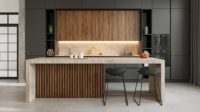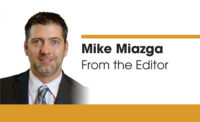Recently, I walked into a spacious room reminiscent of a 1920s classroom that had been transformed into a meeting space. At the front, there stood a massive table surrounded by 12 chairs, all pointed towards a large whiteboard and a video camera. In just a few minutes, four designers, who were half my age, entered the room, impeccably dressed in a style fit for Vogue's Saturday edition, sporting big smiles. We settled down and delved into discussions about our products, and I was genuinely impressed by their enthusiasm for our cabinet hardware.
Let's be honest, cabinet knobs aren't typically the most memorable aspect of a major project. However, their eagerness to engage with the product and learn more about our brand turned our meeting into an entertaining and productive affair for everyone involved. As I was wrapping up, the conversation shifted from decorative hardware to this agency's discovery and specification process.
I discovered that their process involves relatively few actual visits to showrooms and is primarily driven by internet searches on brands they are familiar with and whose styles align with specific projects. Occasionally, they visit showrooms for specific projects, but that's the exception rather than the rule. Their visits to fabric, furniture, and plumbing showrooms are usually for learning purposes, and even those occasions are rare. They glean the most knowledge from interactions like the one we just had—when a vendor or showroom representative visits in person or via a Zoom type meeting, to present their brand and products. And this story repeated itself in just about all of the design firms I visited.
Just as the pandemic demonstrated to decorative showrooms that they could thrive with appointment-only models, talented designers and design firms also discovered that, armed with solid product knowledge, they could effectively plan and specify entire projects from the convenience of their homes or office spaces.
Add to this that plumbers only enter showrooms to ask for pricing and product information, while builders prefer to send in their clients when the need arrives.
This transformation has unfolded over the past three decades, driven by ongoing enhancements in the styling, durability, and overall quality of both valves and trim by decorative plumbing manufacturers. As a result, design and building professionals now have a high level of trust in these products, making the specification process considerably more straightforward.
Over these decades decorative plumbing showrooms have created luxurious destination showrooms that are staffed by knowledgeable showroom consultants. They have created a niche that did not exist in the 80’s and brought it into the mainstream. Bravo! And in 2023, we need to build on this leveraging the same fortitude with tech on our team.
In this early time we need to take small steps and gain an understanding of how this trend playing out in your market and who are it leading proponents.
As noted above, we know that plumbers and builder rely more on their strong relationship with their showroom consultant and only use the showroom when necessary. Engaged or DIY homeowners that are the least bit knowledgeable, know they need a showroom for many reasons. Designers are the key market segment that are in transition and there is where your energy should be focused.
Just as the pandemic demonstrated to decorative showrooms that they could thrive with appointment-only models, talented designers and design firms also discovered that, armed with solid product knowledge, they could effectively plan and specify entire projects from the convenience of their homes or office spaces.
WHERE TO START?
When I was on the showroom side of our business, each showroom had one outside sales person. Their primary call was on the premium and luxury builders to ensure they completely understood our product mix, appreciated how we worked with our good builder accounts and to please send their clients to our showroom. But over time we noticed the designs were contacting and visiting our showrooms at a strongly increasing rate. With that knowledge, we asked our outside sales people to stop calling on the “B” builder accounts and focus that time on the leading design firms incur market. That shift significantly affected our business.
Our showroom consultants listened to the market and helped us understand that the designers in our market were moving from specifying the same products on each job to taking the time to search out the best product for each job. Once we learned that our outside sales people were able to setup decorative plumbing meetings and educate the designer about plumbing and how to use our showrooms. It changed our business.
For your showroom, I recommend that you begin by rallying your team and asking them about their observations regarding customer behavior now that the COVID veil has lifted. Keep these meetings straightforward and focus on how your team perceives the designer selection process as of October 2023.
Instead of posing leading questions like 'What has changed since the pandemic subsided?' Try asking questions such as:
How are your interactions with designers evolving, and how are they utilizing the showroom?'
'What does their specification process entail for the various products they work with?'
'In your opinion, what steps can we take to become more significant and valuable to them?’
Allow your team the freedom to steer the conversation in the direction they believe is most relevant. By granting this flexibility, your team will appreciate that you value their opinions and will feel more engaged in the process of building the strategy they will ultimately implement.
With this valuable information at your disposal, it's time to engage with your top vendor sales representatives and sales managers. Inquire how they see the designer specification process today? Again, try to stay away from leading questions. The purpose is to learn how they see the process.
After compiling all the comments, reconvene with your team to discuss all perspectives and identify the aspects of today’ process that align and do not align with your current go-to-market strategy. Then, collaborate as a team to make necessary changes to those elements that do not align and adjust your strategy accordingly.
THE FINAL TEST
Take this new 2023 strategy and meet with the designers and design firms with whom you have the strongest relationships. In these meetings, you can work together to determine how they would like to collaborate with their key vendors and learn their thoughts on your new ideas for working with them.
By taking small, simple steps, you'll have a fully vetted strategy, an engaged showroom team, and a market ready to collaborate with you.
In our next article, we will explore how to leverage email and focused product meetings to effectively support your showroom team's talents and showcase your vendors' latest and greatest offerings.
Best of luck out there and you would like to discuss this in more depth please reach out to me on LinkedIn or at the upcoming DPHA Conference in Chicago.




